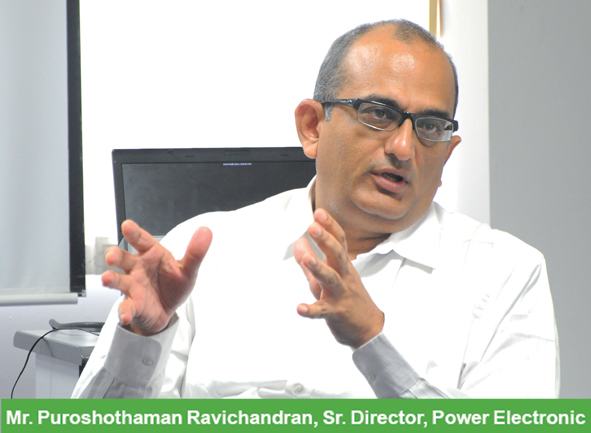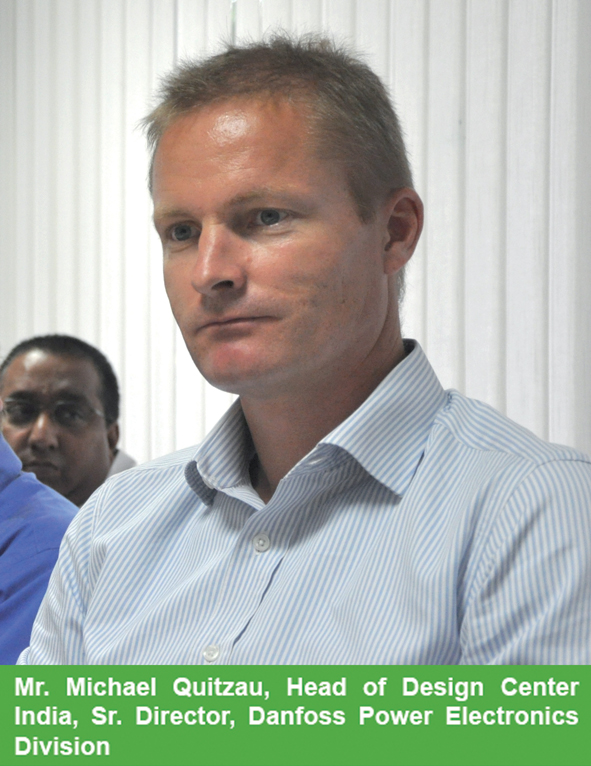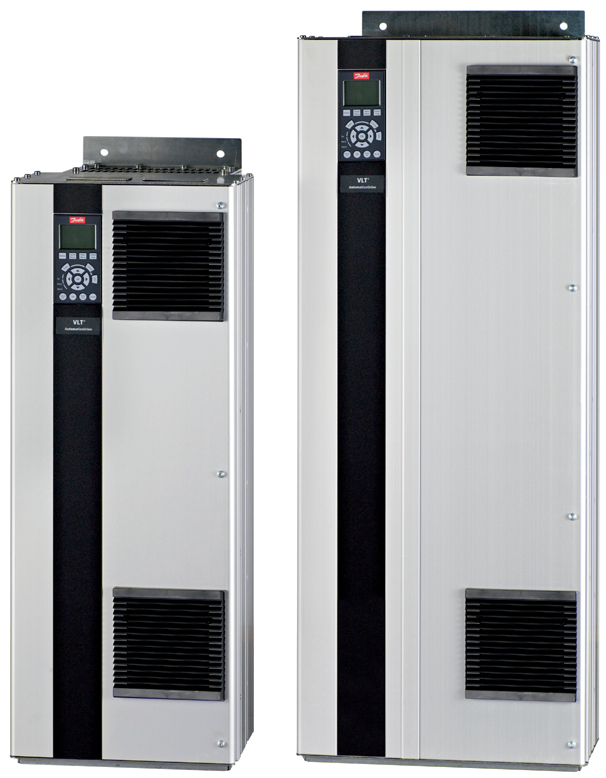The global climate change and energy challenge is a continuing one and in some cases getting bigger. Today, technology is facing higher energy, environmental and application demands that are putting pressure on how products and systems are designed and manufactured. Not just in developed countries but even in emerging economies, energy efficiency has become an important area of focus as energy costs are continuously on the rise. Customers are challenged with the need to be efficient on the energy side and be competitive globally. For a company providing solutions for these challenges there is no doubt a huge future growth opportunity.
 Danfoss is one such company which offers customers solutions that significantly reduce energy consumption making machineries and equipment more efficient. Danfoss has a 75-year history of effectively reducing energy consumption in the heating, refrigeration, air-conditioning and industrial control markets.
Danfoss is one such company which offers customers solutions that significantly reduce energy consumption making machineries and equipment more efficient. Danfoss has a 75-year history of effectively reducing energy consumption in the heating, refrigeration, air-conditioning and industrial control markets.
Danfoss Industries Pvt. Ltd., India is a 100 per cent subsidiary of Danfoss A/S, Denmark. The Indian entity commenced its operations in 1999 with its registered office in Chennai. Danfoss India has 340 employees and revenues of Rs. 352 crores with offices in 10 locations across the country.
Mr. Noel Ryan, President of Danfoss India, says: “Till last year we were just a sales and marketing organization. We have now started focusing on making India an engineering, R&D hub, manufacturing base for India and Asia. We want to do more sourcing from India and have the full scale of activities across the value chain. India is an important market for Danfoss”.
 Danfoss has devised a 2015 plan for the Indian market. The company is planning to build a state-of-the-art manufacturing facility near Chennai at an investment of Rs. 500 crores for both R&D and manufacturing. As part of the plan, Danfoss India plans to raise its headcount from the current 340 to 2000 by 2015.
Danfoss has devised a 2015 plan for the Indian market. The company is planning to build a state-of-the-art manufacturing facility near Chennai at an investment of Rs. 500 crores for both R&D and manufacturing. As part of the plan, Danfoss India plans to raise its headcount from the current 340 to 2000 by 2015.
Danfoss, in India, is committed to offer a global experience to the clients with its quality products. The company caters to a wide range of industries for their component and sub-system, be it the refrigeration and air-conditioning components and controls or the technologically innovative VLT Drives or heating and water controls.
Power Electronics is one of the five broad business units of Danfoss. The Danfoss Power Electronics Division includes three business units – Danfoss VLT Drives, Danfoss Customised Power Electronics and Danfoss Inverters for Solar and Wind.
 Since 1968 Danfoss Drives has been dedicated to developing VLT electronics to control speed, torque, acceleration, synchronisation, positioning, and the overall performance of AC motors. The reliable and innovative VLT drives are designed to support any automation application and provide major energy savings. The modular design makes VLT drives extremely flexible, making it easier to deliver within days highly customised drives, tested from the factory.
Since 1968 Danfoss Drives has been dedicated to developing VLT electronics to control speed, torque, acceleration, synchronisation, positioning, and the overall performance of AC motors. The reliable and innovative VLT drives are designed to support any automation application and provide major energy savings. The modular design makes VLT drives extremely flexible, making it easier to deliver within days highly customised drives, tested from the factory.
There is a VLT drive for any textile application. The product range covers drives and solutions with geared motors and customer-dedicated, low-power solutions. Within the textile business Danfoss Drives holds a strong position in Asia. The textile industry was the proving ground for AC drives, and Danfoss has been an innovator in that application sector from the outset.
Mr. Purushothaman Ravichandran, Senior Director, Power Electronic, Danfoss Industries Pvt. Ltd., says: “Textiles is one of the most traditional industries for Danfoss. We are the global market leaders in the textile industry. We do a lot of joint development with all the big OEMs in this industry. Our strength comes from working closely with our customers. We work with the top customers in the textile industry, both with machinery manufacturers and with end customers”.
 High performance and reliability have always been critical to textile applications, especially when driving multiple motors at high speeds. VLT drives with MCO motion control offer the ultimate solution for textile machinery applications.
High performance and reliability have always been critical to textile applications, especially when driving multiple motors at high speeds. VLT drives with MCO motion control offer the ultimate solution for textile machinery applications.
VLT drives are designed to meet all the challenging environment in textile manufacturing units. They are designed to be extremely reliable and easy to connect, operate and service. Today these drives are used in ring spinning, circular knitting, cone winding, fabric dyeing and other textile applications.
Danfoss VLT drives help save energy and reduce CO2 emissions. They help improve the efficiency of processes and the up-time of machinery and enhance safety and working condition. The drives have a number of features to improve tolerance towards low quality supplies, adding even more reliability to the process.
In the spinning segment, the VLT drives allow for smooth speed control of spindles enhancing productivity for textile companies. Danfoss has been working with prestigious firms like Rajapalayam Mills. VLT control optimizes spindle speeds with minimum variation according to the type of yarn, saving energy and maintaining high quality yarn. In textile applications, Danfoss VLT drives are a cost-effective replacement of conventional mechanical speed control. They also offer kinetic back-up providing control of both deceleration and acceleration in the case of power fluctuations.
“We are clearly in the business of saving energy for our customers, automating processes and improving productivity. We have worked with Rajapalayam Textiles for over two and half decades and helped them produce high quality yarns which are exported to different countries. We are working with our customers closely, understand what they need and adapt our products so that it is able to work and also offer the desired savings to customers”, says Mr. Ravichandran.
“We have set very high aspirations in India, looking at a 20% share of the market by 2015. We want be the top 5 markets for Danfoss Power Electronics in the world and we have the potential opportunity to be there because of the significant opportunity that India offers. We are already market leaders in the textile segment and we want to replicate the same in the other verticals”, he adds.
